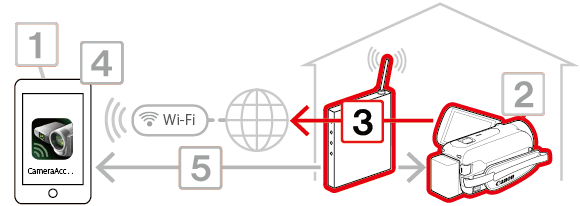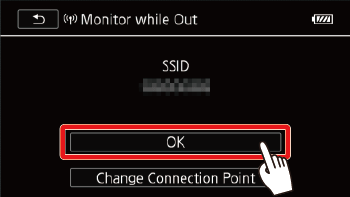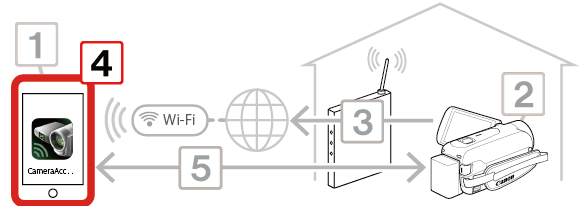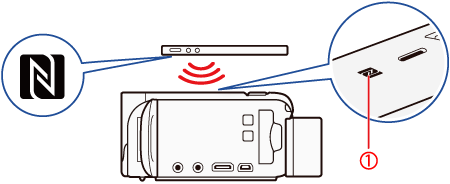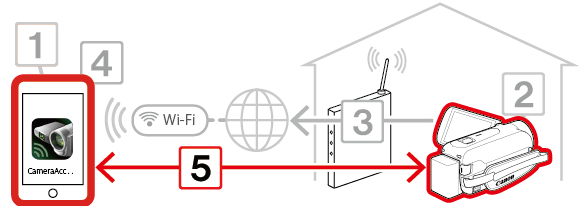Using an iOS/Android device to control the camcorder from another location after setting it up in your home (Remote Control+Streaming) (VIXIA HF R60/R62)
| Article ID: ART100032 | | | Date published: 05/11/2015 | | | Date last updated: 11/04/2015 |
Description
Using an iOS/Android device to control the camcorder from another location after setting it up in your home (Remote Control+Streaming) (VIXIA HF R60/R62)
Solution
| Using an iOS/Android device to control the camcorder from another location after setting it up in your home (Remote Control+Streaming) (VIXIA HF R60/R62) ID : 8202466400 _ EN _ 4 | |||||||||
| Solution | Getting started With this function of CameraAccess plus, you can leave the camcorder home and monitor the streamed image while you are away. You can even use your iOS/Android device to start recording on the camcorder. When using an NFC-compatible Android device, you can connect the camcorder and the device with a simple operation. The procedures for using Remote Control+Steaming are explained in the following five steps. Proceed in order from step 1.  Step 1: Installing CameraAccess plus Step 1: Installing CameraAccess plus Step 2: Performing camcorder password and port configuration settings Step 2: Performing camcorder password and port configuration settings Step 3: Connecting the camcorder to an access point Step 3: Connecting the camcorder to an access point Step 4: Registering the camcorders ID in the iOS/Android device Step 4: Registering the camcorders ID in the iOS/Android device Step 5: Controlling the camcorder with the iOS/Android device Step 5: Controlling the camcorder with the iOS/Android device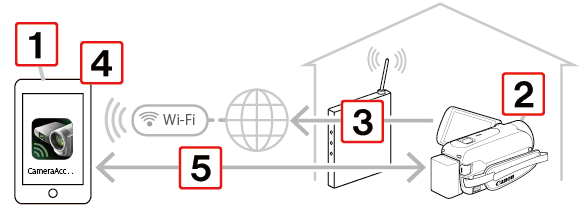
Step 1: Installing CameraAccess plus 1. iOS/Android device: Access the App Store (for iOS devices) or Google Play (for Android smartphones) via your device to download and install the CameraAccess app. If your device supports NFC, you can easily pair the camcorder and the device simply by touching the NFC touchpoints on devices together.
Step 2: Performing camcorder password and port configuration settings 2. Camcorder: Turn on the camcorder and make sure it is set to a recording mode. 3. Camcorder: Touch the [  ] icon displayed on the screen. ] icon displayed on the screen.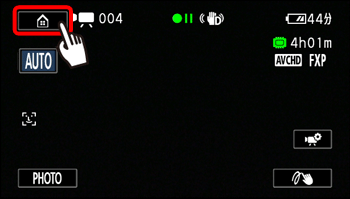 4. Camcorder:  Drag your finger left/right to bring the [Remote Control+Streaming] menu to the center, and then Drag your finger left/right to bring the [Remote Control+Streaming] menu to the center, and then  touch the icon to open it. touch the icon to open it.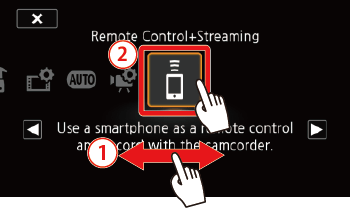 5. Camcorder: Bring [  ] (Monitor while Out) to the center, and then touch [ ] (Monitor while Out) to the center, and then touch [  ]. ].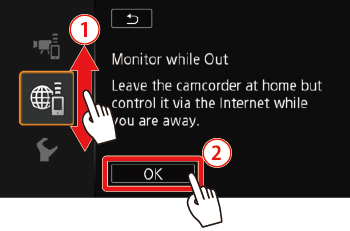 6. Camcorder: Touch [  ]. ].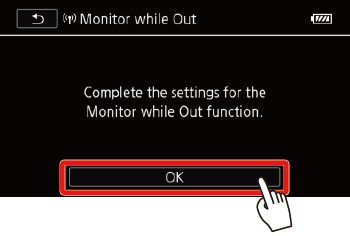 7. Camcorder: Touch the password field. 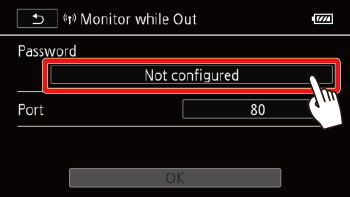 8. Camcorder: Enter a unique 4 and 8 character password for the Monitor while Out function, and then touch [  ]. ]. For more information on entering a password, please refer to the 'Using the virtual keyboard' below. 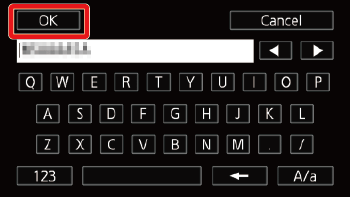
9. Camcorder: Touch the port number entry field. 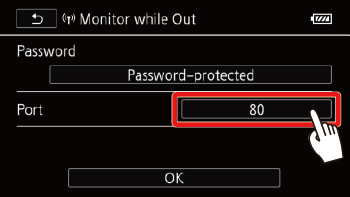 10. Camcorder: Enter the port number, and touch [  ]. ].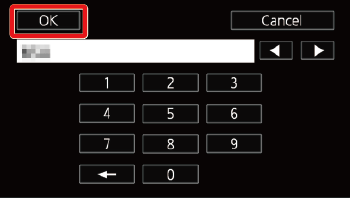
11. Camcorder: Touch [  ]. ].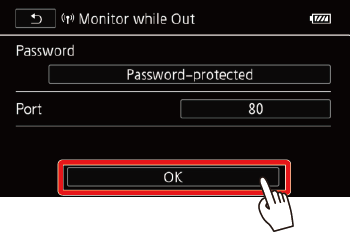 Step 3: Connecting the camcorder to an access point 12. If necessary, set up a connection to an access point.
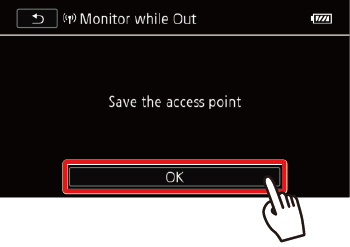
13. Camcorder: Touch the desired connection method. 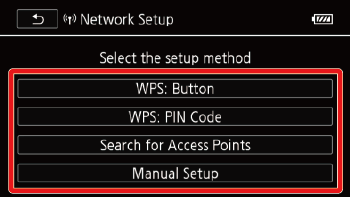 You can select from the following four connection methods. For more information on your access point, please refer to its Instruction Manual.
* WPS, which stands for Wi-Fi Protected Setup, is a standard that makes connecting to a wireless router easier.
If your access point is WPS-compatible , connecting the camcorder to it can be very easy. If you cannot successfully connect the camcorder using WPS, try using the [Search for Access Points] method. [WPS: Button] method: Please proceed to step 14-a-1.[WPS: PIN Code] method: Please proceed to step 14-b-1. Search for Access Points: Please proceed to step 14-c-1. Manual Setup: Please proceed to step 14-d-1.
14-a-1. [WPS: Button] method Press and hold the WPS button on the wireless router.
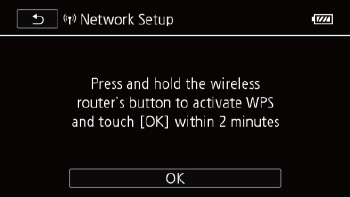 14-a-2. Camcorder: Within 2 minutes, touch [OK] on the camcorders screen. The camcorder will connect to the access point. 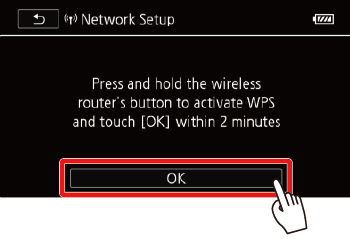 You can touch [Stop] and then [OK] to interrupt the Wi-Fi Protected Setup while it is in progress. 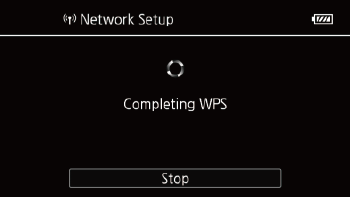 When the Wi-Fi Protected Setup is finished, [Configuration completed] will appear on the screen. 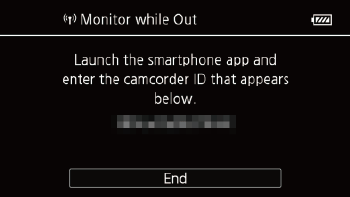 Please proceed to step 15. Please proceed to step 15. 14-b-1. [WPS: PIN Code] method From a computer or similar device connected to the access point, use the Web browser to open the routers WPS settings screen. After the 8-digit PIN code appears on the camcorders screen, enter it into your routers WPS settings screen. 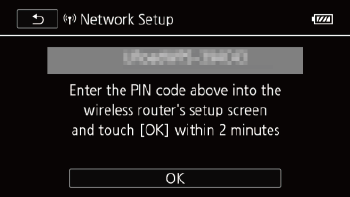 14-b-2. Camcorder: Within 2 minutes, touch [OK] on the camcorders screen. The camcorder will connect to the access point. 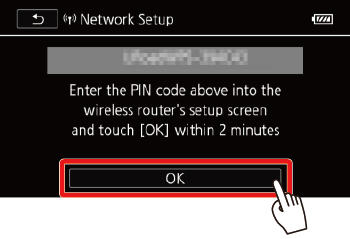 You can touch [Stop] and then [OK] to interrupt the Wi-Fi Protected Setup while it is in progress. 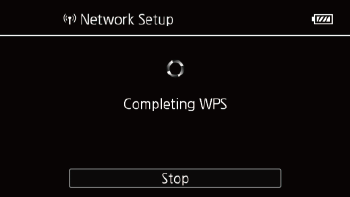 When the Wi-Fi Protected Setup is finished, [Configuration completed] will appear on the screen. 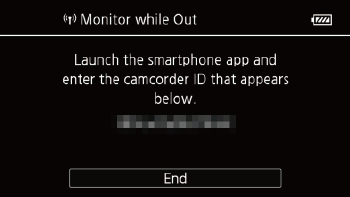 Please proceed to step 15. Please proceed to step 15. 14-c-1.Search for Access Points After you touch [Search for Access Points], the camcorder will take a few seconds to detect access points available in the vicinity and will display the first one. 14-c-2. Confirm the access points setting information. Make a note in advance of the network name (SSID) and password (encryption key) of the access point you want to use. 14-c-3. Camcorder: Select the desired access point. The network name (SSID) of the desired access point appears.  Touch [ Touch [  ] or [ ] or [  ] to select the desired access point from the list. ] to select the desired access point from the list. Touch [ OK ]. Touch [ OK ].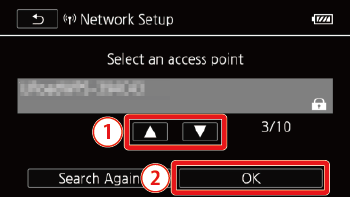 14-c-4. Camcorder: Enter the access points password (encryption key). If the access point selected in step 2-c-3 did not have a [  ] icon, this step is not necessary. ] icon, this step is not necessary. To enter the [Encryption Key] field, touch [Not configured] , and then enter the access points password (encryption key). To enter the [Encryption Key] field, touch [Not configured] , and then enter the access points password (encryption key). Touch [OK]. Touch [OK].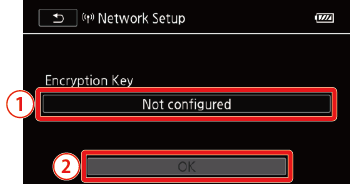 14-c-5. Camcorder: Touch [ OK ]. 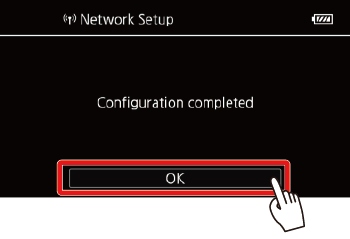 The screen will change once the setting is complete. 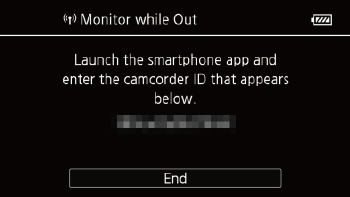 Please proceed to step 15. Please proceed to step 15. 14-d-1. Manual Setup Perform this procedure to manually configure the wireless connection settings. This may be necessary, for example, if your access points network name (SSID) cannot be detected due to the stealth function being enabled. Manual setup is for advanced users of Wi-Fi networks. 14-d-2. Camcorder: Enter the SSID.  Touch the [SSID] field. Touch the [SSID] field. Enter the SSID, touch [OK], and then touch [Next]. Enter the SSID, touch [OK], and then touch [Next].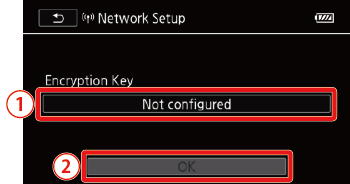 14-d-3. Camcorder: Touch the [Authentication/Encryption Method] field. Touch [OPEN NONE]. 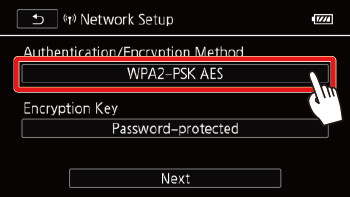 14-d-4. Camcorder: Touch the desired method. If you selected [OPEN WEP], the WEP index is 1. 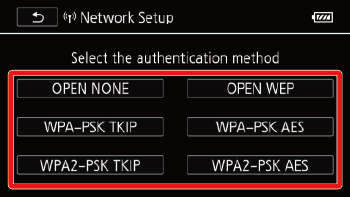 14-d-5. Camcorder: Enter the encryption key. If you selected [OPEN NONE] in step 14-d-4., this step is not necessary.  Touch the [Encryption Key] field, and then enter the encryption key (password). Touch the [Encryption Key] field, and then enter the encryption key (password). Touch [Next]. Touch [Next].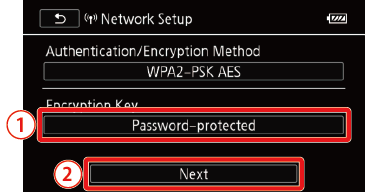 14-d-6. Camcorder: Select how to obtain the IP address. 14-d-7. Camcorder: To enter the [IP Address] field, touch [0.0.0.0]. Touch the first field. 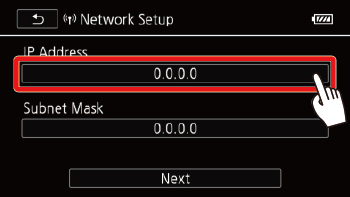 14-d-8. Camcorder: Touch [  ] or [ ] or [  ] to change the value. Change the rest of the fields in the same way and touch [OK]. ] to change the value. Change the rest of the fields in the same way and touch [OK].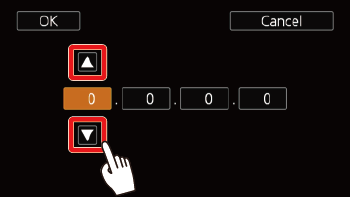 14-d-9. Enter the [Subnet Mask] field in the same way and touch [Next]. 14-d-10. Enter the [Default Gateway] field in the same way and touch [Next]. 14-d-11. Enter the [Primary DNS Server] and [Secondary DNS Server] fields in the same way and touch [Next]. 14-d-12. Camcorder: Save the configuration. Touch [ OK ]. 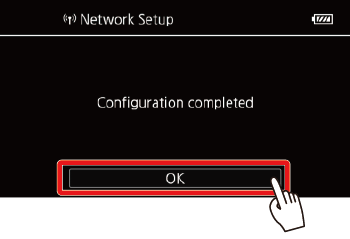 The screen will change once the setting is complete. 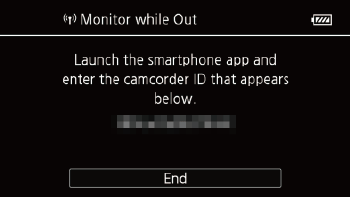 Please proceed to step 15. Please proceed to step 15. Step 4: Registering the camcorders ID in the iOS/Android device 15. iOS/Android device: Register the camcorders ID and password. If the iOS/Android device is connected to the same Wi-Fi network as the camcorder, CameraAccess plus will recognize the camcorder's ID and register it automatically. The iOS/Android device setting procedures for automatic (15-a), and manual (15-b) registration are explained below.
15-a-1. Connect the iOS/Android device to the access point you registered in step 14. 15-a-2. Start the CameraAccess plus app. 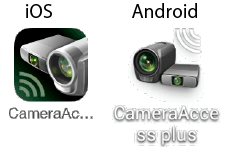 15-a-3. Start the CameraAccess plus app and touch [Setting] and then [Start]. 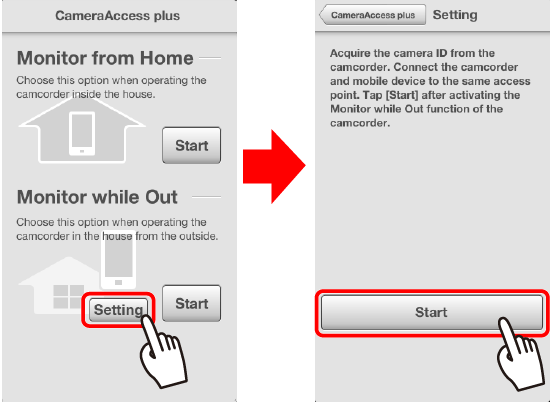 15-a-4. The camcorders ID will be registered. 15-a-5. Touch [End]. 15-a-6. End the wireless connection to the access point.
15-b-1. Start the CameraAccess plus app. 15-b-2. Touch [Start]. 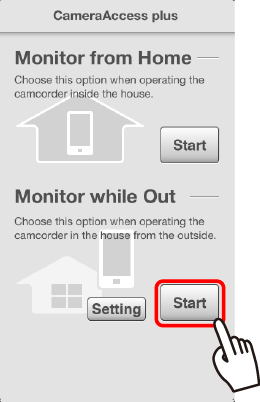 15-b-3. Follow the onscreen instructions to register the ID displayed on the camcorders screen. 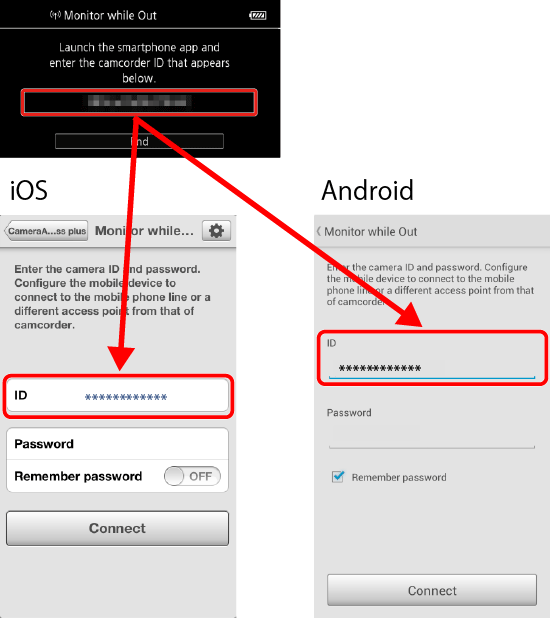 Step 5: Controlling the camcorder with the iOS/Android device 16. iOS/Android device: Start CameraAccess plus while in a secondary location. 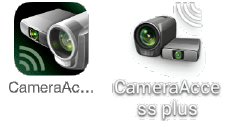
17. iOS/Android device: connect to the Wi-Fi network and touch [Start] under [Monitor while Out]. 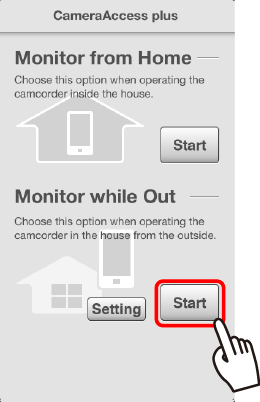 18. iOS/Android device: Enter the password for the [Monitor while Out] function that you set in the camcorder in step 7, and then touch Connect. 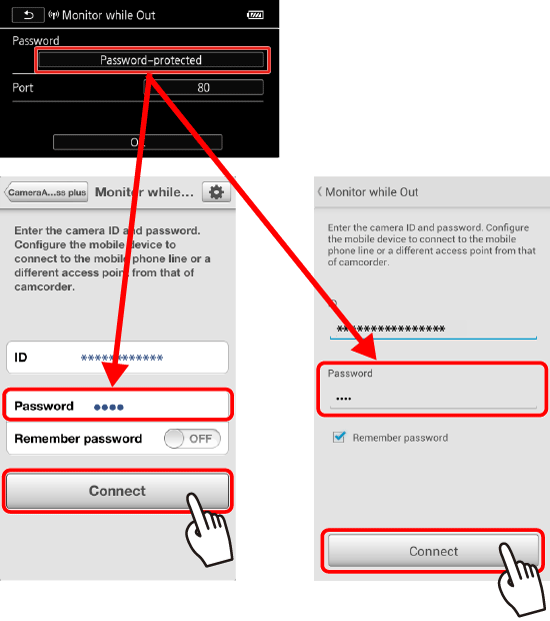 19. iOS/Android device: Use the apps onscreen controls to operate the camcorder while viewing the live image on the device. 20. Camcorder: To end the Monitor while Out mode, touch [End] to end the wireless connection and then turn off the camcorder. 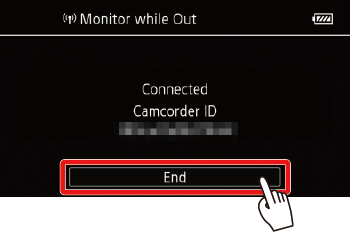
About the optional CT-V1 Camera Pan Table - If you mount the camcorder on the optional CT-V1 Camera Pan Table, you can use the CameraAccess plus app on your iOS/ Android device as a remote control to move the camcorder sideways (panning) in addition to starting/stopping recording. - Notice that there are two possible directions for mounting a camcorder on the CT-V1. This camcorder should be mounted so that the lens is aligned with the  mark on the underside of the CT-V1s camcorder base plate. For details, refer to the instruction manual of the CT-V1. mark on the underside of the CT-V1s camcorder base plate. For details, refer to the instruction manual of the CT-V1.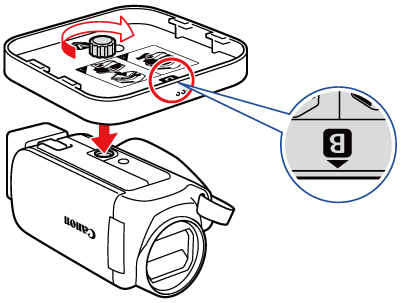 | ||||||||
SIMS Doc Id
8202466400

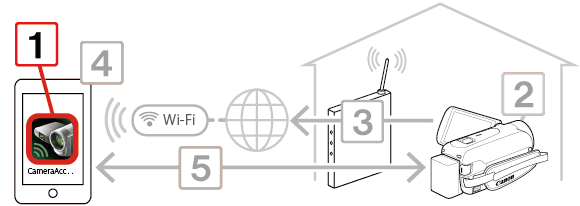
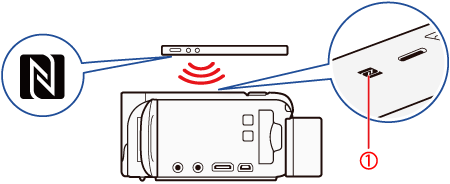
 : NFC touchpoint.
: NFC touchpoint. on the Android device* to the NFC touchpoint
on the Android device* to the NFC touchpoint  >
>  >
>  > [NFC] to [Off] to prevent this.
> [NFC] to [Off] to prevent this. .
. > [Dual recording] or [Relay recording] is activated.
> [Dual recording] or [Relay recording] is activated.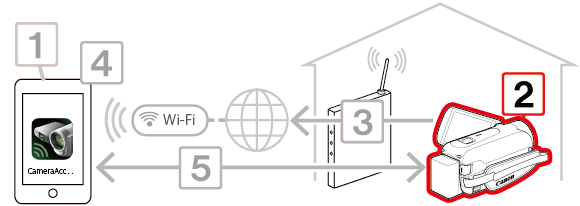

 :
:  (Press to exit after entering the information.)
(Press to exit after entering the information.)  : Text field
: Text field : Letter/number keys
: Letter/number keys :
:  /
/  (Switch between letters and numbers/special characters.)
(Switch between letters and numbers/special characters.) : Space key
: Space key :
:  Backspace (Delete the character to the cursors left.)
Backspace (Delete the character to the cursors left.) :
:  /
/  /
/  Caps Lock. When the numerical keyboard is displayed, [#%?] switches between set 1 and set 2 of special characters.
Caps Lock. When the numerical keyboard is displayed, [#%?] switches between set 1 and set 2 of special characters. :
:  (Change the position of the cursor.)
(Change the position of the cursor.) : Cancel
: Cancel